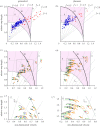Inverted pendular running: a novel gait predicted by computer optimization is found between walk and run in birds
- PMID: 20484229
- PMCID: PMC3001358
- DOI: 10.1098/rsbl.2010.0256
Inverted pendular running: a novel gait predicted by computer optimization is found between walk and run in birds
Abstract
Idealized models of walking and running demonstrate that, energetically, walking should be favoured up to, and even somewhat over, those speeds and step lengths that can be achieved while keeping the stance leg under compression. Around these speeds, and especially with relatively long step lengths, computer optimization predicts a third, 'hybrid', gait: (inverted) pendular running (Srinivasan & Ruina 2006 Nature 439, 72-75 (doi:10.1038/nature04113)). This gait involves both walking-like vaulting mechanics and running-like ballistic paths. Trajectories of horizontal versus vertical centre of mass velocities-'hodographs'-over the step cycle are distinctive for each gait: anticlockwise for walk; clockwise for run; figure-of-eight for the hybrid gait. Both pheasants and guineafowl demonstrate each gait at close to the predicted speed/step length combinations, although fully aerial ballistic phases are never achieved during the hybrid or 'Grounded Inverted Pendular Running' gait.
Figures


 values indicate multiples of step frequency consistent with pendular swing-leg timing and duty factor = 0.5. The region shaded pink (between contours i and iv) is that predicted by numerical optimization to favour (energetically) inverted pendular running (Srinivasan 2006). The grey contour (ii) indicates the maximum boundary for a passive, stiff-limbed vaulter in which gravity provides sufficient centripetal acceleration of the CoM towards the foot to keep the leg under compression. The outer, black curve (iii) indicates the walk–run (run–walk) transition boundary predicted from energy minimization derived from collision mechanics while allowing limb tension. Hodographs from a single guineafowl (c,e) and pheasant (d,f) show the progression from midstances (black/green boundary) through single steps (order: green, orange, black). The right angle (c–f) gives a
values indicate multiples of step frequency consistent with pendular swing-leg timing and duty factor = 0.5. The region shaded pink (between contours i and iv) is that predicted by numerical optimization to favour (energetically) inverted pendular running (Srinivasan 2006). The grey contour (ii) indicates the maximum boundary for a passive, stiff-limbed vaulter in which gravity provides sufficient centripetal acceleration of the CoM towards the foot to keep the leg under compression. The outer, black curve (iii) indicates the walk–run (run–walk) transition boundary predicted from energy minimization derived from collision mechanics while allowing limb tension. Hodographs from a single guineafowl (c,e) and pheasant (d,f) show the progression from midstances (black/green boundary) through single steps (order: green, orange, black). The right angle (c–f) gives a  scale for the hodographs. Grounded inverted pendular running occurs near the grey walk-limit boundary, as indicated by the highlighted figure-of-eight hodographs ((e,f) providing a magnified view of the dashed box regions in (c,d)).
scale for the hodographs. Grounded inverted pendular running occurs near the grey walk-limit boundary, as indicated by the highlighted figure-of-eight hodographs ((e,f) providing a magnified view of the dashed box regions in (c,d)).Similar articles
-
Vaulting mechanics successfully predict decrease in walk-run transition speed with incline.Biol Lett. 2013 Jan 16;9(2):20121121. doi: 10.1098/rsbl.2012.1121. Print 2013 Apr 23. Biol Lett. 2013. PMID: 23325739 Free PMC article.
-
Computer optimization of a minimal biped model discovers walking and running.Nature. 2006 Jan 5;439(7072):72-5. doi: 10.1038/nature04113. Epub 2005 Sep 11. Nature. 2006. PMID: 16155564
-
Low leg compliance permits grounded running at speeds where the inverted pendulum model gets airborne.J Theor Biol. 2020 Jun 7;494:110227. doi: 10.1016/j.jtbi.2020.110227. Epub 2020 Mar 3. J Theor Biol. 2020. PMID: 32142807
-
Patterns of mechanical energy change in tetrapod gait: pendula, springs and work.J Exp Zool A Comp Exp Biol. 2006 Nov 1;305(11):899-911. doi: 10.1002/jez.a.334. J Exp Zool A Comp Exp Biol. 2006. PMID: 17029267 Review.
-
Biomechanical and physiological aspects of legged locomotion in humans.Eur J Appl Physiol. 2003 Jan;88(4-5):297-316. doi: 10.1007/s00421-002-0654-9. Epub 2002 Nov 13. Eur J Appl Physiol. 2003. PMID: 12527959 Review.
Cited by
-
Children and adults minimise activated muscle volume by selecting gait parameters that balance gross mechanical power and work demands.J Exp Biol. 2015 Sep;218(Pt 18):2830-9. doi: 10.1242/jeb.122135. J Exp Biol. 2015. PMID: 26400978 Free PMC article.
-
The goal of locomotion: Separating the fundamental task from the mechanisms that accomplish it.Psychon Bull Rev. 2017 Dec;24(6):1675-1685. doi: 10.3758/s13423-016-1222-3. Psychon Bull Rev. 2017. PMID: 28092079 Review.
-
Mixed gaits in small avian terrestrial locomotion.Sci Rep. 2015 Sep 3;5:13636. doi: 10.1038/srep13636. Sci Rep. 2015. PMID: 26333477 Free PMC article.
-
Minimally Actuated Walking: Identifying Core Challenges to Economical Legged Locomotion Reveals Novel Solutions.Front Robot AI. 2018 May 22;5:58. doi: 10.3389/frobt.2018.00058. eCollection 2018. Front Robot AI. 2018. PMID: 33644120 Free PMC article.
-
A simple extension of inverted pendulum template to explain features of slow walking✰.J Theor Biol. 2018 Nov 14;457:112-123. doi: 10.1016/j.jtbi.2018.08.027. Epub 2018 Aug 20. J Theor Biol. 2018. PMID: 30138629 Free PMC article.
References
-
- Abourachid A.2001Kinematic parameters of terrestrial locomotion in cursorial (ratites), swimming (ducks), and striding birds (quail and guinea fowl). Comp. Biochem. Physiol. A Mol. Integr. Physiol. 131, 113–119 (doi:10.1016/S1095-6433(01)00471-8) - DOI - PubMed
-
- Alexander R. McN.1980Optimum walking techniques for quadrupeds and bipeds. J. Zool. 192, 97–117 (doi:10.1111/j.1469-7998.1980.tb04222.x) - DOI
-
- Alexander R. M.1995Simple models of human movement. Appl. Mech. Rev. 48, 461–470 (doi:10.1115/1.3005107) - DOI
-
- Cavagna G. A.1975Force platforms as ergometers. J Appl. Physiol. 39, 174–179 - PubMed
-
- Cavagna G. A., Heglund N. C., Taylor C. R.1977Mechanical work in terrestrial locomotion: two basic mechanisms for minimizing energy expenditure. Am. J. Physiol. 233, 243–261 - PubMed
Publication types
MeSH terms
Grants and funding
LinkOut - more resources
Full Text Sources

